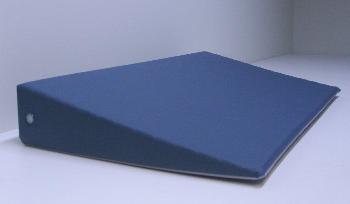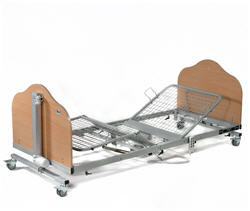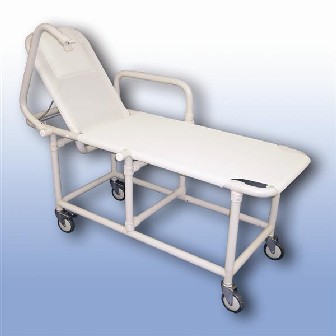Short Description
There are many electric beds on the market with the ability to adjust. They can be height adjustable, usually referred to as Hi-Lo. The headrest angle can be altered to bring a person into a more upright position. A knee break can raise under a person's knees to help prevent them from slipping down the bed. The foot section can be elevated. The bed can also be made to tilt in various directions.
More Details
Electric beds can be used to:
- Enable a person to sit up in bed or change position independently.
- Enable a person to get into or out of bed.
- Make assisting the person easier for a carer.
- Help make a person more comfortable.
Electric bed operation:
- Most often adjusted using a low voltage hand control. A button would be pushed to raise or lower the headrest, knee break or Hi-Lo mechanism (See below).
- The controls can sometimes be customised if someone is unable to operate them for example, buttons or levers can be made bigger and / or repositioned.
Options available with electric beds:
- Headrest angle adjustment brings the headrest from 180 degrees to around 90 degrees although the angle varies with each bed.
- Knee break or knee bend which supports under the knees to help prevent a person from sliding down the bed.
- A mechanism is available which elevates the foot section, instead of under the knees only.
- Hi-Lo mechanism can adjust the height off the ground. Some beds will go down to nearly floor level, but may not go as high as required.
- Some beds can be customised in features required, or size.
- Inbuilt massage units are available.
- Trendelenburg Tilt allows the entire bed to tilt so a person's feet can be higher than their head. Reverse Trendelenburg tilts the bed in the opposite direction.
- Mattress can be inner spring or high density foam.
- Lockable base castors can very in size, but can alter overall height. Extensions can be put on the base to increase overall height of the bed.
- Base can be slatted or a metal frame.
- Extension boards can increase base length if required.
- Head and foot boards may be removed to ease changing the bed.
- Looks can vary with a metal frame, skirting to hide electrics or a wooden base. Panel designs can vary also.
- Size of bed can vary including single, 3/4, Double, Queen, and King size.
- For those bigger than a single bed size, headrest angle adjustments can be as one, or split for two people. It may be worth considering joining two single beds, as there can be complications with the sheets being untucked when one person sits up while the other is lying.
Issues to consider when selecting an electric bed:
- What options are required?
- Does the headrest angle rise as high as required?
- Does the position of the hinges match the required position for sitting up or requiring a knee break? They may push a person forward at the chest instead of their hips which may make breathing more difficult for some.
- Is the height adjustment range suitable?
- Is there clear access under the bed for a mobile hoist if required?
- If a mobile hoist is required, can it lift high and far enough over a bed to lay a person in a comfortable position? i.e. Not too close to the edge.
- Is the mattress appropriate? Does it conform to the angle changes?
- What size bed would be most appropriate?
- What is the weight capacity of the bed.
- Does the bed need to be moved around?
The following are other alternatives to an electric bed which may assist a person to be independent:
- Bed Stick
- Self Help Poles
- Bed Rails and Bed Rail Protectors
- Mattresses designed to prevent people rolling out of bed
- Silk Sheets
- Backrests
- Wedges and different shaped pillows
- Bed Cradles
- Bed Rope Ladders
- Cocoons or sheets zipped to the bed
For more information on these beds and for supplier details, contact the Independent Living Centre. Many companies make or sell electric beds. It may also be worth consulting the yellow pages or larger bedding stores.
Standards
Some assistive technology needs to meet Australian or other standards. Standards may relate to materials, manufacturing and installation. Products that meet Australian or international standards will have written certification. To find out if a product meets Australian Standards ask the supplier to show you the certificate. For a fact sheet about standards contact us or visit www.ilcaustralia.org/home/standards.asp


 subscribers
subscribers 





